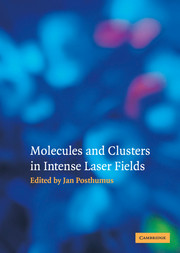Book contents
- Frontmatter
- Contents
- Preface
- 1 Ultra-high-intensity lasers based on Ti: sapphire
- 2 Diatomic molecules in intense laser fields
- 3 Small polyatomic molecules in intense laser fields
- 4 Coherent control in intense laser fields
- 5 Experimental studies of laser-heated rare-gas clusters
- 6 Single-cluster explosions and high-harmonic generation in clusters
- 7 Interactions of intense laser beams with extended cluster media
- Index
4 - Coherent control in intense laser fields
Published online by Cambridge University Press: 29 March 2010
- Frontmatter
- Contents
- Preface
- 1 Ultra-high-intensity lasers based on Ti: sapphire
- 2 Diatomic molecules in intense laser fields
- 3 Small polyatomic molecules in intense laser fields
- 4 Coherent control in intense laser fields
- 5 Experimental studies of laser-heated rare-gas clusters
- 6 Single-cluster explosions and high-harmonic generation in clusters
- 7 Interactions of intense laser beams with extended cluster media
- Index
Summary
Introduction
The last decade has seen impressive progress in the understanding of the elementary mechanisms of chemical reactions. The advent of femtosecond (fs) laser sources has allowed the possibility of analysing ultra-fast chemical reactions using lasers. In pump–probe schemes, a first ultra-short pulse initiates a reaction that is monitored by a subsequent probe laser pulse. This method is extremely useful for recording the formation and the evolution of transition states in real time. With the understanding of these fundamental mechanisms, there has emerged a renewal of interest in the control of photo-induced processes using tailored laser pulses.
The ability to control chemical reactions through a variety of means (catalysis, use of various substrates, variation of temperature, pressure, concentration of the initial reactants, etc.) has major beneficial consequences for chemical synthesis and other industrial manufacturing processes. Not only is it normally useful to speed up a reaction but also, in a case with more than one possible outcome, it can be extremely useful to influence the branching ratios of the various fractions. This can result in a far greater yield of the desired product, with the elimination of by-products. Classical methods of chemistry sometimes fail to produce a specific product from a given set of reactants. This is the case, for instance, when the reaction is under thermodynamic control and one wants to produce a metastable species.
- Type
- Chapter
- Information
- Molecules and Clusters in Intense Laser Fields , pp. 114 - 141Publisher: Cambridge University PressPrint publication year: 2001



